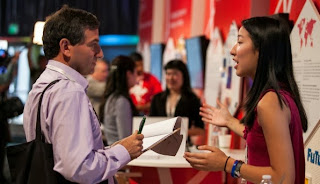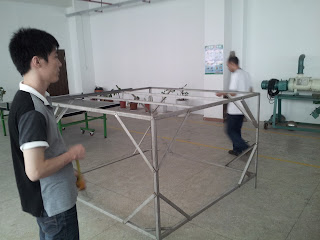(from the archives of T.H. Culhane, Ph.D.
January 8 2011
reprinted after working with WMST Public Charter School 9th grader and Porpoise Robotics Blender Protege Benjamin Standfield to create the Sea Perch and Sea Sparrow/MantaRay Robosub and Roboboats in a 3D gaming environment. This kid really knows how to "speak 3D!")
Do you speak 3D?
Can you talk in "animated object"? Can you communicate in "graphic novel"? Do you speak in pictures?
Moving pictuers?
Pictures that move people?
Today's children are growing up in a world where those may soon be legitimate questions.
We often say that "a picture is worth a thousand words" but we still assume that only a small percentage of humanity will ever really develop the skills to be considered a true "artist". Speaking in pictures, moving or static, 2d or 3d, is still considered the domain of "experts".
But it needn't always be.
On January 8, 2011 in the German newspaper, "Stellen" (nrw.stellenanzeigen.de) the front page article was
"Experten fur 3D-Welten: Qualifikation -- Neue Technologie wird in vielen Branchen gebraucht."
The English translation: "Experts for 3D Worlds: (Get) qualified -- these new technologies will be needed in many fields".
The accompanying picture shows a worker wearing a special three dimensional visualization technology that allows him to manipulate virtual objects in thin air. The caption reads, "Das Arbeiten mit virtuellen und 3D Welten ist gefragt -- mit Qualifikationen kann man sich fit dafur machen." (My loose translation: "Working with virtual and 3D worlds is in demand -- with the right qualifications one can make oneself fit for the new jobs").
The article goes on to inform the readers in this historical working class area of Germany that many of the new jobs -- in the auto industry, in medicine, in architecture and planning, to say nothing of film and games -- demand facility with 3D visualization. But they point out that getting qualified can take more than 6 months of intense study, and that the education system is not yet equipped to equip students (much less retrain the rest of us) for this sudden demand. In addition, training courses can cost as much as 400 Euros a day and the software is very expensive. However, they conclude, for those who are truly motivated, there are tutorials on-line and there is open source software available.
An interesting state of affairs. There is a tacit assumption that the ability to translate an idea into three dimensions requires special training and that certain barriers to entry for this heretefore domain of experts will (should?) always exist. But is this so?
Whenever I think of 3D worlds my imagination takes me to a place I've only ever seen in a two dimensional landscape -- the Sea of Monsters in the Peter Max designed Beatles cartoon "Yellow Submarine". There, amidst a host of marvelous beings, a quadrupedal winged clown walks around "speaking" three dimensional objects into existence. When we first see him he opens his mouth and we see him produce an ice cream cone. The vacuum monster ambles over and sucks it up. With consternation he then speaks a gas station, an Egyptian pyramid and a colorful tie into existence. Then the marvelous 3D talking clown gets sucked into oblivion ("or even further" as John Lennon quips...).
But while this incredible talent for reifying thought gets annihilated and lost to the sea monster gene pool in Yellow Submarine, that great two dimensional representation of the way the Beatles made people feel in the late 1960s , it may in fact be evolving right here in our own three dimensional world here on Earth in the early two-thousand-teens.
I envision a day not long from now when technology and our facility with it allows us to answer questions by conjuring objects and animated processes into audio-visual existence in real time. We would describe a building or a motor or even an emotion by instantly placing the object or representational graphic in front of the people with whom we are conversing.
On the road to that version of reality we still have a lot of work to do, but in my mind it starts with teaching our children (and ourselves) that it is normal to "speak 3D". Rather than continuing to operate in linear 2d spaces, painstakingly training ourselves and our youth to put letters together into words and words into sentences and then paragraphs and then pages, all from left-to-right (if you are in the Western tradition) with the proper punctuation and all just for the purpose of describing a room, setting up a scene or describing a vector of motion and emotion, we can start now training them to operate in what my post-modern urban planning professor Ed Soja calls "third-space" -- a non linear environment where the medium truly is McCluhan's massage and our message.
The problem with descriptions of third space (also the title of one of Ed's highly stimulating books) is that they normally are only ever done in second space. Ed writes about this brave new world using normal textual conventions. In lectures he speaks about it from "left to right", from "beginning to end", following the normal prepared-speech-for-the-lecture-hall format. "Speech" is still two dimensional. And we need people who can think, and act, in 3D.
So what do we do?
One of my first stabs at training myself to think and speak 3D was to read and study Scott McCloud's mind-opening "Understanding Comics -- The Invisible Art" (and moving on to his equally riveting sequels
"Reinventing Comics: How Imagination and Technology Are Revolutionizing an Art Form" and "Making Comics").
Now I am toying with writing reports using the software program "Comic Life" rather than Microsoft Word, and trying to think not only about how to use pictures and graphs to illustrate points better, but how to use layout and space, size and color, and other design principles like gradation, repitition, unity, contrast, and harmony (what my father, animation historian John Culhane, used to call "GRUCH" so I would remember them!).
My next steps are doing all the tutorials I can find and find time for to better my skills in the Gimp, Sketchup, Blender, Unity 3D, Celtx, CamStudio, Suicidator City Generator, MakeHuman, Scribus, Elder Scrolls Construction Set, Sims3 and other animation, game engine, 3d visualization audio and video production software (like many in the NGO/Philanthropy world I can't afford Maya, 3D Studio Max or Cinema 4D so I use what I can find).
When I answer questions about our work on solar hot water systems and biogas systems in the real world, I try more and more to answer them using these software resources and the techniques of audio-visual production and graphic representation I'm learning from book's like McClouds.
In effect I am trying to learn to speak 3D. And to carry on a conversation or give an explanation using hypertext, illustrative hyperlinks and some good 2D and moving representations of the three dimensional (really n-dimensional) reality we inhabit.
In my line of work it is actually very important to develop these skills now, not in the future, because so many of the people we are trying to reach (in our sustainable development efforts) are separated from us by language barriers and cultural barriers and class barriers and lots and lots of real three dimensional space.
The use of multi-media, of music and video and gaming and -- let's face it -- FUN -- are paramount in importance if we want to share real solutions for empowering people and preserving or creating healthy environments. This is a point His Excellency former Nigerian President Olusegun Obasanjo made both publically, when we presented together at the melody-dialouge for civilization conference in Geneva, and privately when I stayed at his home last summer building biogas digestors with his family and community. We are both on the board of the UNESCO sponsored Melody Dialouge organization because we and many others (like Melody Dialouge founder Mehri Madarshahi and 5D founder Tali Krakowsky and I think all of us who participated in the FMX conference) believe that we must act now to use all available channels of communication for the necessary dialogue about real things that humanity must come together on to preserve (and better) civilization.
And so this was the intent of creating this forum on Blending Realities here on facebook -- to create multiplier effects and accelerators, share insights and skills so that we can be part of that evolving generation of human beings who not only thinks, but who eventually, inevitably will speak, in surround sound, melodic and musically intoned, audio-visually enhanced, animated 3D.
Or should we say 5D?
Can you speak 5D?
Visiting Facuty Researcher
School of Health and Natural Sciences and Social and Behavioral Sciences






































































































